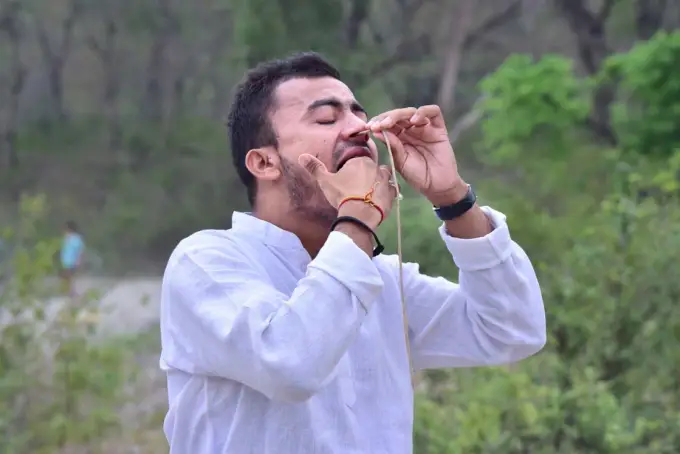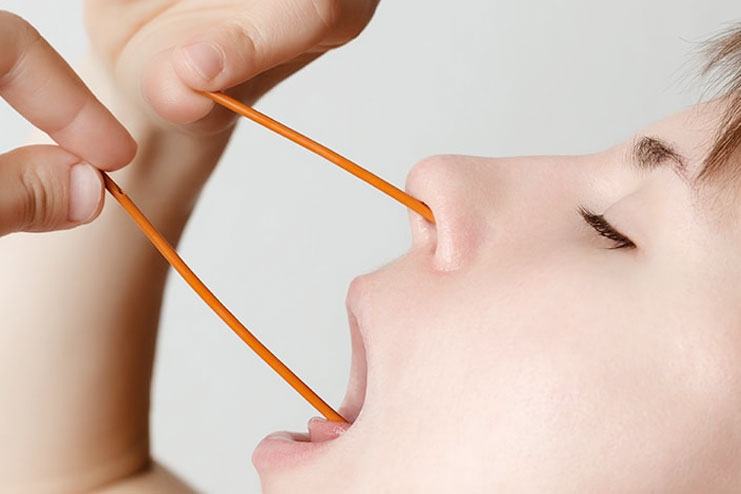Neti Sutra is a yoga breathing exercise that uses soft thread to clear the nasal passages and outer respiratory tracts of congestion. The delicate thread is first placed inside one nostril and then tries to exit through the mouth.
Repeat the procedure on the other nostril as well. Once the procedure is mastered, it can be placed via one nostril and attempted to exit through a different nose. However, one thing to keep in mind is that it should always be done under the guidance of a yoga specialist.
Neti is one of 6 cleansing techniques of Shatkarma;
- Dhauti – A Cleansing technique for the upper stomach
- Neti – Nasal cleansing technique
- Nauli – Massages abdominal organs
- Basti – Cleansing of the large intestine
- Kapalbhati – Forehead shining breathing technique
- Trataka – Eyes muscles purification exercise
There are mainly 4 types of Neti kriya; Jal Neti, Sutra Neti, Dugdha Neti, and Ghritha Neti. Jala Neti is the easiest one where saline water is used to clean the nasal passages.
What is Sutra Neti?
Sutra is a Sanskrit term that literally translates into ‘Thread‘ and Neti is used here for ‘Nasal Cleaning‘
Sutra Neti is a nasal passage cleansing technique using a cotton thread or rubber catheter. It’s also called Thread Neti or rubber Neti based on the type of thread you use. Yogic texts like Hatha Yoga Pradipika and Gheranda Samhita defined it with great detailing.
In Sutra Neti, A cotton thread or a rubber catheter is inserted into the nostril in a way that it comes out of the mouth. In this way, mucus and debris are removed and hence nasal passages are opened to their fullest capacity. It has also proved to be beneficial in nasal polyps.
Thread used in Neti Thread used in Neti Sutra
A cotton thread was traditionally prepared for use as a Neti sutra by being dipped in melted beeswax to make it hard enough to pass through the tiny nasal canal and come out of the mouth unhampered. Before immersing it in the beeswax, the thread is knotted together with a number of strands.
Today, the waxing process is no longer necessary because of the availability of rubber catheters, which may readily perform the same tasks as waxed sutra Neti cotton thread when greased with saliva or ghee.
As a result, the sutra Neti process is now also known as rubber Neti. Although the size of the catheter varies on the user’s nasal channel, most people can use sizes 4, 5, or 6 as Neti sutras with success.
The Neti sutra should be between 36 and 45 cm in length and have a thickness of about 4 mm.
A normal yogi can use cotton thread that is 4mm wide and around 36 cm long for Sutra Neti. This thread’s length is sufficient to reach through the mouth and down the nose.
Sutra Neti kriya cotton thread can be purchased through an internet retailer or is readily available in stores.
But while using cotton thread for Sutra Neti, be sure to grease it with beeswax (or another lubricant) as failure to do so could result in nausea.
Another thread for Sutra Neti is a tiny rubber catheter. A 1 to 3-mm thick, tube-like thread known as a rubber catheter is relatively soft and can be inserted into the nostril.
Since a thin rubber catheter is more lubricated than a cotton thread and can slide more easily through nasal passages, it is recommended for novices.
Understanding Nasal Cavity Anatomy Before Neti Sutra
Neti Sutra beginners should be well-versed in the tissues from where the thread is passed as well as the anatomy of the nasal cavity.
The nasal passageway looks like a long cave. The floor is large and the roof is slender. A valve connects the upper rear of the neck to the area close to the nose’s root.
It’s crucial to maintain the thread’s direction toward the throat’s back. It should be lowered and drawn in. It ought to be simple to slide down into the nose’s back aperture.
The entire treatment ought to be painless. If discomfort is felt, the method needs to be examined, and the string needs to be entered again in the right direction and at the right pace.
To perform, adhere to the steps below.
How To Do Sutra Neti

- Take a string made of thread that has been covered in beeswax, or use a rubber catheter in its stead. Dry the chord correctly after rinsing it in warm water, special oils, or drugs.
- Gently and slowly insert a thread into one of the nostrils. Keep the cord pointing in the direction of the throat’s rear.
- With your index and middle fingers, insert your hand into your mouth and seize the chord at the base of your throat.
- Pull the thread out of the mouth slowly and carefully by reaching for it towards the back of the throat.
- Move the string twice or three times while holding both ends with both hands.
Apply the same procedure to the opposite nostril. - Neti Sutra can be performed by transferring the cord from one nostril to another once the previous process is mastered.
Frequency and time of practice
The best time to perform Neti Sutra is in the morning, just before breakfast, when nasal passages are naturally most open.
Neti Sutra should not be practiced daily but rather once a week. It can decrease the natural receptors found in our nasal passages if someone practices it often.
Benefits of Neti Sutra

These are some immediate and long-term advantages of Neti Sutra that you will experience if you practice it as directed by a professional.
1. Lightness in breathing
Neti Sutra is a technique that helps clear the thick nasal passages of extra mucus after doing jail Neti. Additionally, thread unblocks the mucous membrane, which makes breathing even lighter.
2. Improves Vision
Numerous delicate nerves in the area of the front and back of the nose are related to the eyes, and they are stimulated when the thread is passed through them. This stimulation enhances a person’s overall vision by increasing the blood flow via these nerves.
3. ENT care
Internal connections exist between the ENT (eyes, nose, and ears) systems. Any blockage has the potential to disrupt the other two organs as well.
The simplest method of treating ENT (eyes, nose, and throat) issues is regular Neti Sutra practice. Jal and Neti Sutra is a natural cure for anyone, whether you have irritated vocal cords, nasal congestion, or ear pain.
4. Alleviate Inflammation and excessive mucus
Neti Sutra is a technique for clearing blocked sinus cavities of mucus that have become a source of inflammation. When the mucus in the nose dries out, it can sometimes block the nose.
When Neti Sutra is massaged, the mucus obstructions are released, which reduces the discomfort and blocked nose.
5. Deviated nasal septum reduced
Some people’s deviated septa lead to numerous breathing-related issues. In this situation, an ENT expert frequently recommends surgery.
The natural treatment for a deviated septum is Neti Sutra. Although treatment takes time, you will eventually notice a reduction in the obstruction caused by a deviated septum.
Other benefits
The thread used in Neti Sutra works as a stimulator for nerves and membranes in the nose which relieves the symptoms of cough, cold, and headache symptoms.
Also, the dormant cells in the frontal brain area are activated which enhances hair growth, and memory and reduces insomniac.
Precautions
- You gain the most benefits from Neti Sutra practice, so make sure to follow these recommendations.
1. Don’t force thread into the nose
Sutra (thread) may not easily pass through the nasal passages for a number of physical or mechanical reasons. In this situation, avoid pushing thread into nostrils on purpose since it can pierce delicate nasal tissues and result in bleeding.
2. Practice it before the pranayama session
Neti Sutra, like other Shatkarma, should be performed prior to asana and pranayama practice as it aids in facilitating adequate breathing during pranayama practice by fully opening the nostrils.
See More: A Complete Guide to Pranayama (Yogic breathing)
3. Perform it after Jal Neti
Jal Neti is a comparably easy and quick practice as compared to Neti Sutra. Practice Jal Neti before performing sutra Sutra as it will moisturize the nasal passages, so that thread will easily pass through the nostrils.
4. Ensure the thread is clean and trimmed properly
A thread could have several sticky dust particles attached to it. Use warm saline water to thoroughly rinse the thread, and then set it aside to dry before inserting it into the nostrils.
Additionally, if you are substituting a thread for a rubber catheter, make sure the thread ends are appropriately clipped to prevent curling as it exits the mouth.
A Scientific Explanation of the Sutraneti
The mucosa of the respiratory region may experience a slight irritation as a result of Sutra Neti’s practice. It aids in clearing the air that is inhaled of debris, undesirable substances, trapped secretions, or deposits. Its effectiveness has been the subject of extensive scientific research.
Contraindications to the practice of Jal-neti
There are not many contraindications to Jal-Neti, but they are still there:
People suffering from a history of chronic nasal bleeding, nasal polyps, and hypertension, in any condition, practice Neti Sutra by consulting with an expert. Also, avoid doing Sutra Neti during sinus problems.
- Tendency to experience frequent sinus or middle ear irritation. Even if certain disorders have already manifested, Jal-Neti is still a possibility.
- The first signs of a runny nose
It is essential to begin perfecting the technique in the summer using water that is just a little bit warmer than body temperature if a person has an upper respiratory tract disease.
Sutra Neti and Jala Neti, two yoga techniques, have been discussed in this article. Stay fit!





















